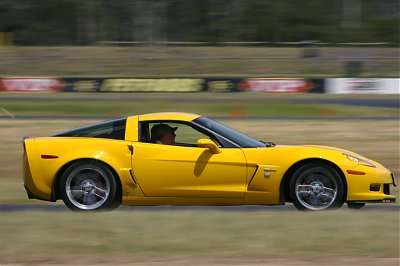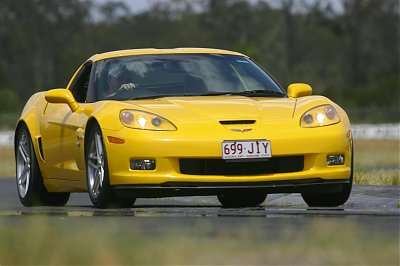|
| |||||
|
Corvette Z06 with RHD
19th February, 2007 | ||||
|
Packing an LS7 7.0 litre alloy V8 engine, hydroformed lightweight body
structure, carbon fibre panels and race-bred suspension, the Chevrolet Corvette
Z06 is the fastest production car General Motors has ever made. Drawing on a 54-year heritage as America's iconic sports car, the Z06 holds
its head high also as one of the world's best, boasting stunning straight line,
cornering and braking performance. The 2007 Chevrolet Corvette Z06, is now on sale in Australia through Performax
International, offering unprecedented capability and technology, making it one of
the best-value performance buys among the rarified ranks of the world's
fastest road cars. The Z06's LS7 engine delivers 377 kW in a 1,421 kg package.
According to GM official figures, this produces 0-97 km/h
performance of 3.7 seconds in first gear, A quarter-mile time of 11.7 seconds at
102 km/h. In Germany, it lapped the Nürburgring circuit - the benchmark
test for super cars - in 7 min. 43 sec. The Z06, available only in coupe form, is based on a hydroformed backbone
structure, which features cored composite floors, an enclosed centre tunnel,
rear-mounted transmission and aluminium cockpit. This advanced design results in
a light but rigid basis for the all-aluminium suspension. Inside, the interior is inspired by Corvette's dual-cockpit tradition.
High-quality materials, craftsmanship and functionality help enhance the driving
experience. LS7 V8 At the heart of the Z06, the highly-developed LS7 returns the legendary
"427 cubic inch" engine to the Corvette vocabulary. Unlike the
earlier "big-block" 427 engine, the 7.0-litre LS7 is a small-block unit - and the
largest-displacement small-block ever produced by Chevrolet and GM. LS7 shares the same basic Gen IV V8 architecture as the Corvette C6's
6.0-litre LS2, but uses a different block casting with steel cylinder
liners. The dry-sumped LS7 also has a different front cover, oil pan, exhaust
manifolds and cylinder heads, among many other special components. Internally, the LS7's reciprocating components make use of racing-derived
lightweight technology, including titanium connecting rods and intake valves, to
help boost power and rpm capability - the rev limit is reached at 7,100. Special LS7 features include: The titanium connecting rods weigh just 464 grammes each, almost 30 percent less than the steel rods in the LS2. They are also extremely durable. CNC-ported aluminium cylinder heads are designed to meet the airflow demands of the engine's 7.0-litre displacement - 18 percent more than the LS2. A hydraulic roller camshaft is used. To ensure optimal, uninterrupted airflow, the LS7's heads have straight, tunnel-like intake runners. Very large by production-vehicle standards - and even racing standards - they are designed to maintain fast airflow velocity, providing excellent torque at low rpm and exhilarating horsepower at high rpm. The heads feature 70 cc combustion chambers fed by huge, 56 mm titanium intake valves. The lightweight titanium valves weigh 21 grammes less than the stainless steel valves used in the LS2, despite the valve head having 22 percent more area. They are complemented by 41 mm sodium-filled exhaust valves, compared with 39.4 mm valves in the LS2. To accommodate the large valve diameters, the heads' valve seats are siamesed. The LS7 has a dry-sump system designed to keep the engine fully lubricated under high lateral cornering loads. An engine compartment-mounted reservoir delivers oil at constant pressure to a conventional pick-up at the bottom of the engine. The pick-up is continually immersed in oil at cornering loads exceeding 1g. A high efficiency air-to-oil radiator provides necessary cooling. The hydroformed four-into-one headers discharge exhaust gases via catalytic converters to "bi-modal" mufflers. The mufflers each feature a vacuum-actuated outlet valve, which controls exhaust noise during low-load operation but opens for maximum power, delivering a stirring, muscular engine note. Drivetrain A single-mass flywheel and lightweight, high-capacity clutch channel torque to the rear transaxle. The six-speed ZF manual gearbox - only manual is available in the Z06 - has been strengthened to handle the LS7's increased torque. The transmission includes a pump that sends oil to a front radiator for cooling. The fluid removes additional heat from the differential before returning to the transmission. The gearbox connects to a limited-slip differential and then through strengthened half-shafts with tougher universal joints to the rear wheels. Chassis The Z06 has a unique aluminium body structure for optimum stiffness and light weight. Perimeter rails are one-piece hydroformed aluminium members featuring cast suspension nodes, which replace many welded steel components on other Corvette models. Other castings, stampings and extrusions are combined into the structure with state-of-the-art technologies. Advanced structural composites featuring carbon fibre are bonded to the aluminium. The wider front wheelhouses, for example, are carbon composites and the passenger compartment floors combine carbonfibre skins with an ultra-lightweight balsa wood core. A magnesium cradle serves as the attachment point for the engine and some front suspension components. The lightweight cradle helps improve the front-to-rear weight distribution, as do carbon fibre front guards and wheelhouses. The battery is re-located from the engine compartment to the boot. Suspension, brakes The Z06 retains the 2,686 mm wheelbase of other Corvette models, as well as the short-long arm (SLA) suspension and transverse leaf spring design, but it rides on all-new wheels, tyres and brakes, as well as its own rear spring and roll stabiliser. Wheels are cast-spun aluminium, 18 in. x 8.5 in. with P245/40ZR18 tyres at the front and 19 in. x 10 in. rims with P285/35ZR19 tyres at the rear. It's the largest wheel-and-tyre combination ever offered on a Corvette. Tyres are Goodyear Eagle F1. Ironically, due to Australian regulatory requirements, the original new tyres are replaced with identical tyres that must be certified as "new" and fitted locally. Fittingly, the Z06 comes with enormous stopping power - 355 mm vented and cross-drilled front rotors and 340 mm vented and cross-drilled rear rotors. Red-painted six-piston calipers incorporating six individual brake pads are employed at the front. Individual brake pads are used because they deliver more equalised wear compared to what would otherwise be a very long single-piece pad. At the rear, four-piston calipers are used on the brakes, again with four individual pads. ABS is a Delphi four-channel system, coupled to traction control and an Active Handling system, incorporating a "competition" mode. Design The Z06 has an unmistakable and aggressive appearance, with design cues that
include:
The aerodynamics of the Z06's exterior were shaped by the experiences of the Corvette racing programme, where high-speed stability and cornering capability are paramount. And while the race cars use large rear wings, the Z06's elevated spoiler provides sufficient downforce to balance front splitter without adversely affecting aerodynamic drag. The Z06's Cd is 0.34. For all its race-inspired functionality, the Z06 is designed to be a daily drivable high-performance vehicle. Comfort and convenience levels are of a very high standard. High-Intensity Discharge lighting, fog lamps, leather seating, dual-zone air conditioning, cabin air filtration and head-up display (HUD) with track mode and G-meter are standard. Australian versions feature supportive sports seats upholstered in perforated leather with crossed-flag embroidery and contrasting stitching. An AM/FM radio with CD player and MP3 capability is standard. It's All Right (Hand Drive) In Australia
The Chev Corvette Z06, manufactured only in left-hand drive in Bowling Green, Kentucky, undergoes a conversion for right-hand drive Australian roads at Performax International in Gympie, Queensland. All vehicles carry full Australian Design Rule compliance, with work performed in-house to certified ISO Quality Assurance standards, ensuring customers can have complete confidence in their investment. The process of converting a new Z06 to road-ready right-hand drive takes four weeks. Work such as moulding all-new fascia and door panels is done by Performax International and achieves original equipment standards of fit and finish, thanks to the use of CAD-CAM design and many years of experience. The conversion process includes –
The result is a vehicle that retains its ex-factory look and feel. Performance and other dynamic aspects are unchanged. | |||||
ABN 47106248033 |
 |
All rights reserved. |

